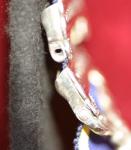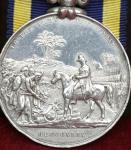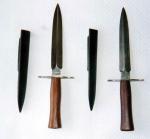-
Posts
29,251 -
Joined
-
Last visited
-
Days Won
84
Content Type
Profiles
Forums
Blogs
Gallery
Events
Store
Everything posted by Chris Boonzaier
-
A seller we know? Was it sent insured?
-

EK 1914 I will show you,
Chris Boonzaier replied to Chris Boonzaier's topic in Germany: All Eras: The Iron Cross
I had moved from EKs to Luftwaffe, to EK Docs... The pictured ones are not really ones I have looked for... they have more or less followed me home... you know the scenario... you want to buy an EK doc on Ebay and the seller insists on selling it with an EK that never belnged to the guy... -
On the Brit Medals forum there was an initial sceptisism toward this medal as the Gooj bar is on the medal, the chili loose on the ribbon. But I think that has cleared itself up. The medal was issued with the Gooj, and it seems only later that his Chili bar was confirmed (on his records, but not on the roll)
-
"On January 9th Gough started advancing. The new Sikh position was on the left bank of the Jhelum and faced about cast, covering a front of six miles. Most of the Sikh regulars were on the right of this line, in front of which stretched rough ground covered with jungle: to the left, where the Sikh irregulars were posted, the ground was steeper and ravines rendered it almost inaccessible. The position was partially entrenched and the Sikhs, who numbered nearly 30,000 to Gough's 13,000 had over sixty guns, so that an attack was not to be hastily undertaken. The firing had hardly opened before the British bugles sounded the 'Alarm,' followed by the 'Assembly,' and in a minute the men were standing to t heir arms, ready to unpile and fall in. Caught by surprise though they were there was no disorder or confusion, and if Gough had been taken at a disadvantage, mainly through the difficulties of reconnoitring, he did all he could to rectify the position. To a man of his temperament retreat was out of the question, and anyway it would have exposed the troops to considerable losses from the enemy's guns. Attack was the only possible course, ........ The jungle was so thick that Campbell, thinking it to be hopeless to try to control both brigades, went off to the outer flank to direct Hoggan's movements and connect them with those of the cavalry, merely telling Pennycuick and the Twenty-Fourth that there was to be no firing but the work was to be done with the bayonet. About 3 p.m. therefore the advance started, the Twenty-Fourth in the centre of the brigade, with the grenadier company out in front as skirmishers. The enemy's exact position and the distance to be covered were unknown, and after covering about 200 yards the troops plunged into a thick jungle, in which direction and formation were alike hard to keep. More than once the line had to break into echelon of companies, and to recover formation in the jungle was almost impossible. As Captain Blachford put it, 'whole sections of companies were constantly obliged to be doubling and filing in rear, so that it was very difficult to keep the line in anything like order.' At first, the advance was steady enough, but when the battalion came within range of the enemy's guns a tremendous fire was opened and almost instinctively the pace quickened. Whether Pennycuick ever ordered the charge will never be known. Sir Charles Napier, who investigated the matter carefully, is emphatic that he did not, that the change from 'an advance in quick time' into 'a rush forward' was quite spontaneous, the inevitable result of 'the excitement of danger,' the 'zeal of the soldiers to close with the enemy' and the impossibility of controlling the advance in such country. He is emphatic that 'there was nothing for a brave and able commander to do but what Colonel Pennycuick did-dash forward, cheering on his men, and by his example supporting the impulse he could not check and ought not to check.' Even if the Twenty-Fourth charged at too great a distance from the enemy it was 'the noble course,' and had the regiment's rapid advance only been properly supported all might have been well. Unfortunately no support was forthcoming, for the Twenty-Fourth, already ahead of the Sepoys on their flanks, increased their lead at every stride. Moreover, they seem unfortunately to have to some extent masked the fire of the supporting guns, while the men tended more and more to bunch where the jungle was the thinnest and easiest to penetrate, and it was just on these points that the Sikh guns were trained. At one point in particular a large pond surrounded by scraggy trees blocked the way and forced two companies to file to the flank, which increased the bunching. Still there was no holding or checking the Twenty-Fourth. 'The regiment' writes one survivor, 'never wavered for an instant, but pressed on without firing a shot.' Macpherson has described how the line pushed forward into the dense jungle, the men 'answering the crash of the enemy's fire with loud cheers' and pressing on undauntedly, though grape, canister and round shot swept them down in scores. 'My company,' he writes 'was near the centre where the Colours were as a target to aim at. One discharge of grape seems to have swept away my right section-for a moment I am alone, still unhurt. On, on we go . . . . the goal is almost won . . . . the ground becomes clearer, the flashes from the guns more vivid, we can now dimly see through the smoke the Sikhs labouring at their guns . . . . bayonets come down to the charge and with wild, choking hurrahs, scarcely a shot having been fired, though our men were loaded, the battery is won.' Campbell was emphatic in his praises. 'It is impossible,' he wrote, 'for any troops to have surpassed... the gallantry displayed in this attack. This single regiment actually broke the enemy's line and took the large number of guns in their front.' Napier was no less warm: 'their conduct,' he declared, 'has never been surpassed by British soldiers on a field of battle.' It was the grenadier company, now on the right flank, who first reached the guns, the jungle in its front having been less thick than elsewhere. A counter-attack drove it back, but Captain Travers promptly rallied it and a second advance carried the position, the rest of the regiment arriving almost simultaneously. Round the guns a desperate struggle raged: the Sikhs fought furiously for their cherished pieces and only after a desperate resistance were the gunners overcome. Sikh infantry from rising ground in the rear blazed away vigorously, not minding if they shot down their own gunners if they could cheek the victorious Twenty-Fourth. Some of the men had been provided with jagged nails to jam into the touch-holes to render the guns unserviceable and several were treated in this way. Lieutenant Lutnam, one of Macpherson's tree-climbing companions, has described how he contrived with the aid of Private Stanfield of the grenadier company to put one gun out of action, and another was spiked by Sergeant Lear of the same company, but before the majority could be disabled the Sikh infantry were counter attacking in force and the remnant of the Twenty-Fourth was hard pressed to hold its ground. It was indeed a remnant, the centre companies in particular having been virtually annihilated, and if, as Napier grandiloquently wrote, it was 'master of the position' and its 'glory was complete,' it was alone in its glory, 'isolated and unsupported.' The whole Colour-party had been shot down, both Lieutenant Phillips and Ensign Collis being killed when within a few yards of the guns, where Colonel Pennycuick also fell, his son, the junior Ensign, just joined from Sandhurst, who dashed to his father's side, being shot down as he reached him. Colonel Brooks was attacked by three Sikhs, who dashed out from under the guns, but they were bayoneted by men of the grenadier company. The Colonel, however, was killed almost immediately afterwards; two Majors, Harris and Paynter, were desperately wounded, Captain Travers of the grenadier company was cut down by a swordsman, and before long two-thirds of the officers had been disabled and very few were left to direct the resistance to the vigorous counter-attacks of the Sikh infantry. The particularly heavy losses, which the centre companies had suffered, proved a special disadvantage. The line was weakest in the centre and the counter-attack, breaking in here, separated the battalion into two wings. No support was forthcoming from the Sepoy regiments whom the regiment's rapid advance had left far behind and, fighting desperately against overwhelming numbers, its remnants were thrust back through the jungle, losing heavily as they fell back. Not until the open ground on the far side of the jungle was reached was it possible to rally and reform. Altogether the Regiment, which had gone into action with 31 officers and 1,065 NCOs and men, had 13 officers and 225 men killed, 9 officers and 278 men wounded, in all nearly half its strength. The Queen's Colour was lost, It may have fallen into a pool when its bearer, Lieutenant Phillips, was hit; another account says that the staff was broken, and that Private Connolly wrapped the Colour round his body to secure it, but he too was killed and presumably buried without the Colour being discovered. It certainly never fell into the Sikh's hands, as did the Colours of the 25th and 45th NI. Had the Sikhs secured it, they would have certainly displayed it to a British officer, a prisoner in their camp, to whom they proudly exhibited their other trophies. The Regimental Colour, rescued by Private Perry when Ensign Collis fell, was safely brought in." It now hangs in the Regimental Chapel in Brecon Cathedral, together with the Queen's Colour presented in 1850.
-

Gone mad on Brit lately....
Chris Boonzaier replied to notned's topic in Great Britain: Orders, Gallantry, Campaign Medals
Very nice indeed !! A very lucky find. -

EK 1914 Schutztruppe Iron Crosses....
Chris Boonzaier replied to Chris Boonzaier's topic in Germany: All Eras: The Iron Cross
-

EK 1914 I will show you,
Chris Boonzaier replied to Chris Boonzaier's topic in Germany: All Eras: The Iron Cross
Hi, some have spent the night in concentrated vinegar, some have just been painted with anti-rust paint. Best Chtis -

EK 1914 I will show you,
Chris Boonzaier replied to Chris Boonzaier's topic in Germany: All Eras: The Iron Cross
HI, They are all EK2s, I got rid of my EK1s years ago, have maybe 5 or 6 WW1 EK1s floating around. Best Chris













